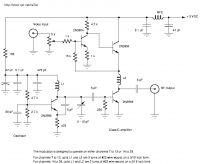neazoi
Advanced Member level 6
Hi, I am trying to find the best way to feed the video into a small video modulator.
One way is this one http://electronics-diy.com/electronic_schematic.php?id=889 and another way is this one http://danyk.cz/tvvys_en.html
Which way is it better and leads to more stable operation?
I do not understand what is the purpose of the diode and if the DC blocking capacitor is better to be there, or whether direct coupling (like the first circuit) is better. Isn't direct coupling affect the bias as well, so that it leads to more unstable operation?
One way is this one http://electronics-diy.com/electronic_schematic.php?id=889 and another way is this one http://danyk.cz/tvvys_en.html
Which way is it better and leads to more stable operation?
I do not understand what is the purpose of the diode and if the DC blocking capacitor is better to be there, or whether direct coupling (like the first circuit) is better. Isn't direct coupling affect the bias as well, so that it leads to more unstable operation?
Last edited:
